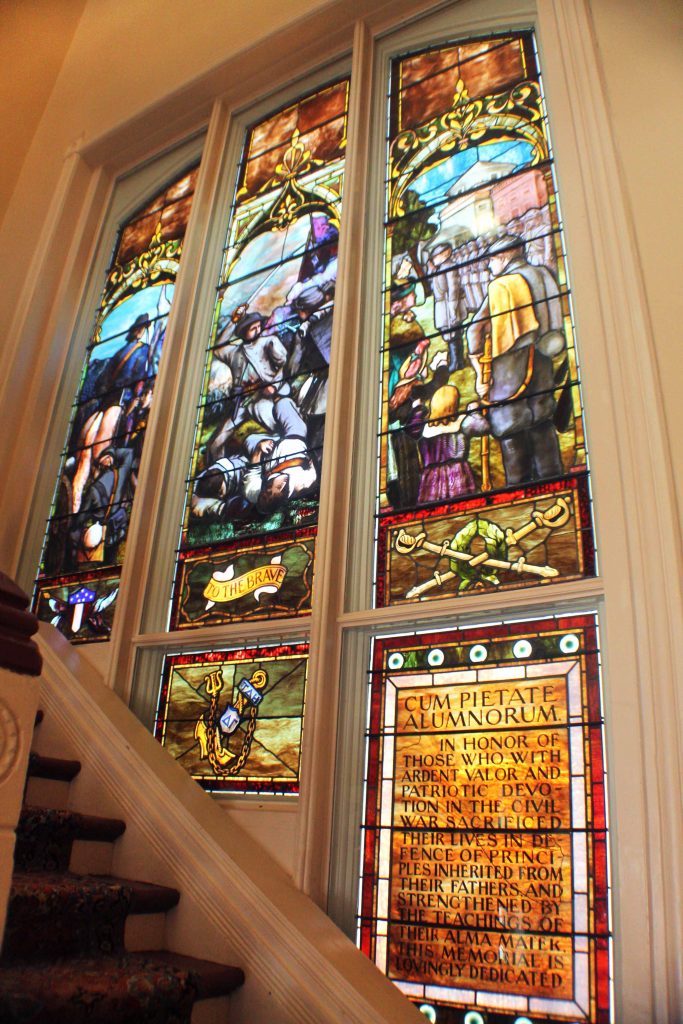Several recent votes by campus governments called for the Confederate monument that stands at the center of the University of Mississippi to be relocated to the Confederate cemetery, but the Tiffany stained glass window that also commemorates Confederate soldiers in Ventress Hall remains largely left out of the conversation.
The 12-foot-high stained glass window that stands in Ventress Hall was donated by Delta Gamma sorority and the Alumni Association in 1889, over a decade before the Confederate monument in the circle was erected. The window was dedicated to the University Greys, a branch of the Confederate Army composed primarily of students from the University of Mississippi who were all casualties of the Civil War.

“When making decisions about the ways in which the past shapes our campus we must be mindful not to erase important history,” John Neff, former member of the Chancellor’s Advisory Committee on History and Context (CACHC), said. “We have deep connections with the University Greys. They were here, in our dorms and classrooms. They trained for war here. They left from our depot to go to war. In ways we should not avoid or erase, they belong here.”
Ventress Hall, though it now stands as the College of Liberal Arts, was the first free-standing library at the University of Mississippi. According to Andy Mullins, former member of the CACHC, the window was constructed in an appropriate place “to depict and remember our fallen student soldiers.”
“I believe that Confederate relics, statues, monuments (and) memorials are fine in their proper place, like battlefields, cemeteries, museum archives and libraries, and that window was placed there by a student group in honor of another student group,” Mullins said.
Jarrius Adams, president of the university gospel choir and a supporter of the effort to relocate the Confederate statue, said that neither the student body nor the CACHC has to make ‘one size fits all’ decisions about Confederate symbols.
“Reckoning with this past is ongoing and won’t happen overnight,” Adams said. “Something that seems benign in one moment may seem completely unacceptable a year or two later. That’s okay, because that means we’re learning and listening to one another and growing.”
Adams said the initial conversation to relocate the monument started because the monument is a “much more highly visible symbol of the Confederacy” and is “unmissable.”
The stated purpose of the statue is to commemorate the soldiers of Lafayette County, and unlike the stained glass, it has no direct historical relevance specifically to the University of Mississippi.
“The monument is not in a historically appropriate context,” Neff said. “It is on our front doorstep. In that prominent place, it purports to represent us, our ideals, our values. And while that may have been true in 1906, but it is not true any longer. We have outgrown what it represents.”
According to Neff, the monument held a place on our campus grounds for 113 years, but no member of the university community took part in its conceptualization, design or construction. The administration only accepted its placement on campus.
He said the stained glass seems to represent personal mourning, which should be perceived differently from honoring Confederate soldiers as a group.
The three panels were crafted by Tiffany’s Glass Company and chosen to compose a story and represent the history of the University Greys.
According to the CACHC, the first panel depicts the student soldiers practicing drills outside of Barnard Observatory. The middle panel illustrates a battle scene, and the final panel captures the surrender of the Army of Northern Virginia at Appomattox Court House.
“As a historian of Civil War memory, I see (the window) as an artifact of memorialization, initiated by students of the university to remember the students who went to war,” Neff said. “I interpret the three panels as representing their training on campus, the experience of combat and the experience of surrender.”






